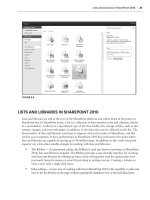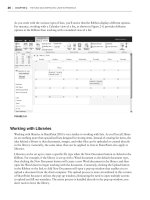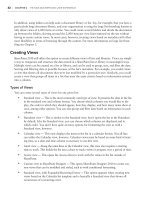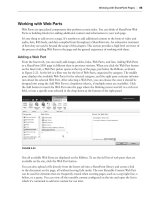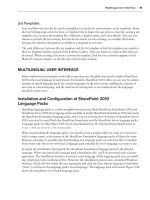Thủ thuật Sharepoint 2010 part 64 pptx
Bạn đang xem bản rút gọn của tài liệu. Xem và tải ngay bản đầy đủ của tài liệu tại đây (683.6 KB, 8 trang )
Content Types
❘
463
CONTENT TYPES
Content types are a powerful feature within SharePoint that provide a single point of management
of common document or list types. Content Types were introduced with SharePoint 2007 and could
be used within any single site collection. If you needed to use content types across multiple site col-
lections, the content types had to be deployed and managed at each of the site collections. This
restriction made the use of global content types difficult in many organizations.
With the release of SharePoint 2010, many of these restrictions have been removed. Within managed
metadata services, along with the Enterprise Term Stores, SharePoint administrators can configure
a Content Type hub. This Content Type hub will be responsible for managing content types that can
be published to all site collections that are consuming the services provided in the managed metadata
service. Keep in mind that a single site collection can consume multiple managed metadata services.
The Content Type hub is configured once for each managed metadata service. Any site collection
to which the Service Owner has access can be configured to be the site collection hub. Figure 16-22
shows the Managed Metadata Service configuration screen with the option for selecting the Content
Type hub to be associated with the specific managed metadata service. Content Type hub configura-
tion settings can be found in the Managed Metadata Service properties page.
FIGURE 1622
When selecting the Content Type hub, you also have an option to report any syndication errors.
This is important because it provides detailed information about specific content that is not cor-
rectly deployed to all consuming site collections. When a site collection is configured as a Content
Type hub, the Content Type Syndication Hub feature is automatically activated, enabling the neces-
sary features to become available for the site collection to publish content types.
464
❘
CHAPTER 16 maNaged metadata service aPPlicatioNs
Additionally, several new options become available on the Site Settings page and the Content Type
settings page. These new options control the ability to publish content types and review specific
errors from the publishing process.
Content type publishing is controlled by two different timer jobs, the Content Type Hub and the Content
Type Subscriber. The Content Type Hub timer job manages the maintenance logs and the unpublished
content types. When this timer job is run, content types that have been identified to be published are
made available to the Content Type Subscriber timer job. The Content Type Subscriber job is created
for each of the web applications and is responsible for retrieving published content types and making them
available in the local content type galleries for the subscribed site collections. The timer jobs are run on
a default schedule, but you can update the schedule to match your organization’s needs. Figure 16-23
shows the different timer jobs; notice that there is one global Content Type Hub timer job but a Content
Type Subscriber job is created for each web application.
FIGURE 1623
Content Types
❘
465
Creating and Publishing Content Types
Once the Content Type hub has been created, users who have access to the hub can create and man-
age the content types that will be published to the subscribing sites. The creation of the published
content type follows the same creation process for nonpublished content types. The difference is that
when a user is working within a site that has been created as a Content Type hub, additional con-
figuration options are available in the Content Type management screen. The additional options are
shown in Figure 16-24 and explained in detail in the following sections below.
FIGURE 1624
Publishing, Unpublishing, and Republishing Content Types
Once a content type has been created in the Content Type Gallery on the hub site collection, it
can be published to the subscribing site collections. The Content Type Publishing dialog, shown in
Figure 16-25, allows you to Publish, Unpublish, or Republish a content type. Notice that it also dis-
plays the timestamp for the last successful publication.
466
❘
CHAPTER 16 maNaged metadata service aPPlicatioNs
FIGURE 1625
There are three specific publishing options, explained in Table 16-3.
TABLE 163: Content Type Publishing Options
PUBLISHING TYPE DESCRIPTION
Publish Make this content type available for download for all web applications (and site
collections) consuming content types from this location.
Unpublish Make this content type unavailable for download for all web applications (and
site collections) consuming content types from this location. Any copies of this
content type being used in other site collections will be unsealed and made into
a local content type.
Republish If you have made changes to this content type, the content type needs to be
“republished” before the changes are available for download to web applications
consuming content types from this location.
When a content type is initially published, it becomes available to the subscribing site collections.
Within the subscribing site collection, the various published content types can be viewed using the
Content Type Publishing option, available in the Site Collection Administration section on the Site
Settings page. This configuration screen, shown in Figure 16-26, shows the different hubs that the
site is subscribed to, the specific content types that have been published from those hubs, as well as a
link to see the publishing error log.
Content Types
❘
467
FIGURE 1626
When site collection administrators click on a published content type, they will be directed to the
settings page within their site collection. From this screen, site collection administrators can config-
ure the advanced settings options for this content type, as shown in Figure 16-27.
FIGURE 1627
From here, the site collection administrator can configure a custom template for the content type,
mark the content type as read only, and enforce an update to all content types that inherit from this
content type.
468
❘
CHAPTER 16 maNaged metadata service aPPlicatioNs
Once a content type has been published to the subscribing sites, site collection administrators in the
subscribing sites can use the published content type as a parent content type for new content types.
This is done by accessing the Content Type Gallery and creating a new content type. All published
content types are available from the Parent Content Type dropdown, shown in Figure 16-28.
FIGURE 1628
Whenever the content type is updated at the hub, it needs to be republished in order for the subscribing
sites to receive the updates. The process for republishing is the same as publishing. Within the Content
Type management screen, select the option to Manage Publishing Options. You will see that once
the item has been published, the default option on the screen is set to republish. Clicking OK on this
screen will cause the content type to be updated the next time the timer jobs run.
Whenever you have a published content type that needs to be removed from the hub, it fi rst needs
to be unpublished. The process of unpublishing a content type has a minimal effect on the sites sub-
scribing to the content type. When a content type is unpublished from the hub, for any subscribing
sites that have implemented the content type, a local content type will be created within the Content
Type Gallery. The content type can then be updated within the gallery; however, any documents
that were associated with the previously published content type will become read-only, and will not
be updated if the associated content type in the gallery is updated.
Not all items associated with a content type can be published through the Content
Type hub. Two specifi c examples include associated workfl ows and lookup col-
umns. Any time a content type with associated workfl ows is published, the work-
fl ows will only work on the subscribing sites if the workfl ow is currently available
within that site.
Content Type Service Application Error Log
The Content Type Publishing hub includes a feature that allows for the reporting of syndication
errors. This syndication error list is available within the Content Type hub site collection. The list is
Summary
❘
469
updated whenever the update timer jobs are run and provide detailed information about any specific
errors that occurred during the synchronization. Figure 16-29 shows an example of this log.
FIGURE 1629
Table 16-4 identifies the information presented within this log.
TABLE 164: Error Log Fields
FIELD DESCRIPTION
Title Error title.
Taxonomy Service Store ID ID of the service.
Taxonomy Service Name Name of the service.
Content Type Subscriber Site Link to site with syndication errors.
Syndication Item The content type that is unable to synchronize.
Syndication Failure Stage The stage at which the syndication failed. Examples include pre-
import checks or importing of workflows.
Syndication Failure Message The specific details outlining what caused the syndication errors.
Syndication Failure Time The timestamp of the error.
SUMMARY
The Managed Metadata service enables you to create, organize, and maintain a complete data-tagging
solution for your organization. By providing the capability to create open term sets, SharePoint 2010
enables any organization to deploy both controlled and ad hoc content to users in a way that is famil-
iar and easily accessible through products they already know and use. Content types enable you to
create repeatable content structures that can be managed in a single location and deployed globally.



